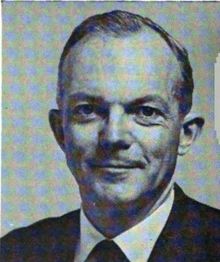John F. Seiberling
| John Frederick Seiberling, Jr. | |
|---|---|
 |
|
| 1973 | |
| Member of the U.S. House of Representatives from Ohio’s 14th district |
|
| In office January 3, 1971 – January 3, 1987 |
|
| Preceded by | William Hanes Ayres |
| Succeeded by | Thomas C. Sawyer |
| Personal details | |
| Born | September 8, 1918 Akron, Ohio |
| Died | August 2, 2008 (aged 89) Copley, Ohio |
| Political party | Democratic |
| Spouse(s) | Elizabeth Behr |
| Children | three |
| Alma mater | |
| Military service | |
| Allegiance | United States |
| Service/branch | United States Army |
| Years of service | 1942-1946 |
| Battles/wars | World War II |
| Awards | Legion of Merit |
John Frederick Seiberling, Jr. (September 8, 1918 – August 2, 2008) was a United States Representative fromOhio. In 1974, he helped to establish what later became the Cuyahoga Valley National Park, and served on the House Judiciary Committee that held the impeachment hearings against President Richard Nixon.[1]
Contents[hide] |
Biography[edit]
Born in Akron, Ohio, Seiberling attended the public schools of Akron, and Staunton Military Academy in Virginia. He received his A.B. from Harvard University in 1941. His parents, Lieut. John Frederick Seiberling (1888–1962) and Henrietta McBrayer Buckler (1888–1979), had been wed on October 11, 1917 in Akron, Ohio. He had two sisters: Mary Gertrude Seiberling (born 1920) and Dorothy Buckler Lethbridge Seiberling (born 1922). His paternal grandparents were Frank Seiberling, the founder of Goodyear Tire and Rubber Company, and Gertrude Ferguson Penfield. His maternal grandparents were Julius Augustus Buckler and Mary Maddox.
During World War II he served in the United States Army from 1942 to 1946. He was subsequently awarded theLegion of Merit for his participation in the Allied planning of the D-Day invasion.[2]
He married Elizabeth “Betty” Behr, a Vassar graduate, in 1949. They have three sons: John B., David and Stephen.
Seiberling received his LL.B. from Columbia Law School in 1949. In 1950, Seiblerling was admitted to the New Yorkbar and went into private practice. He became an associate with a New York firm from 1949 to 1954, and then became a volunteer with the New York Legal Aid Society in 1950. From 1954 to 1970, he was an attorney with Goodyear. He once took a leave of absence rather than cross the picket lines during a United Rubber Workers strike.[2][3] During this time he was a member of the Tri-County Regional Planning Commission in Akron from 1964 to 1970.
In 1970, Seiberling won the Democratic nomination for Ohio’s 14th congressional district, based in Akron. Running on an anti-Vietnam War platform, he then defeated 10-term Republican William H. Ayres by 12 points in a major upset. He would be reelected seven more times from this district,[3] He never faced substantive opposition in what became a solidly Democratic district. Indeed, he won each of his seven reelection bids with over 70 percent of the vote.
His political legacy in the House includes playing a key role in a number of successful major, bipartisan parkland and environmental protection legislative efforts, including enactment of the massive Alaska National Interest Lands Conservation Act of 1980.[4] He also participated in the 1975 Congressional delegation meetings in the Middle East that helped precipitate the 1979 Israel-Egypt Peace Treaty.[2] He did not run for reelection in 1986, and endorsed Akron Mayor Tom Sawyer as his successor.
After his time in Congress, Seiberling served as faculty at the law school of the University of Akron from 1992 to 1996.
On January 8, 2001, he was presented with the Presidential Citizens Medal by President Clinton.[5]
On Thursday, October 12, 2006, President George W. Bush signed into law H.R. 6051, which designates the Federal building and United States courthouse in Akron as the John F. Seiberling Federal Building and United States Courthouse.[6] Seiberling died of respiratory failure at his home in Copley, Ohio on August 2, 2008.[1]
John Seiberling’s cousin, Francis Seiberling, was also a U.S. Representative from Ohio (Republican). His mother, Henrietta Buckler Seiberling, was a seminal figure in Alcoholics Anonymous’ founding and core spiritual ideals.[7][8] His paternal grandfather was Frank Seiberling, founder of the Goodyear Tire and Rubber Company.[7] The family’s one-time home, Stan Hywet, is now a national museum.[7]
Notes[edit]
- ^ a b Downing, Bob (2008-08-02). “John Seiberling is dead at 89”. Akron Beacon Journal. Retrieved 2008-08-02.[dead link]
- ^ a b c Walker Snider (2005).
- ^ a b Downing, Bob (2008-08-03). “‘An American hero’ dies: Retired congressman who represented Akron for 16 years praised for his tireless work creating Cuyahoga Valley park, preserving wilderness”. Akron Beacon Journal.
- ^ Gingles, John – “My Tenure as a Congressional Liaison”, from John Gingles, A Personal Memoir, Washington, D.C., 2007.
- ^ The White House – Office of the Press Secretary
- ^ President Designates United States Postal Service, Courthouse and Federal Building Facilities
- ^ a b c University of Akron (n.d.).
- ^ www.aabibliography.com (n.d.).
References[edit]
- John F. Seiberling at the Biographical Directory of the United States Congress
- Nelson, Daniel, A Passion for the Land: John F. Seiberling and the Environmental Movement. (Kent: Kent State University Press, 2009. xiv, 263 pp.isbn 978-1-60635-036-2
- University of Akron (n.d.). Henrietta Buckler Seiberling, 1888-1979. Retrieved 2007-11-20 from “Akron Women’s History” athttp://www3.uakron.edu/schlcomm/womenshistory/seiberling_h.htm.
- Walker Snider,Jane (2005). Profiles in Service: John & Betty Seiberling. Retrieved 2007-11-20 from “Akron Council on World Affairs” athttp://www.akronworldaffairs.org/newsletter/features/seiberling.html.
- www.aabibliography (n.d.). Henrietta Buckler Seiberling (1888–1979). Retrieved 2007-11-20 from “An Illustrated Alcoholic Anonymous Bibliography” athttp://www.aabibliography.com/henrietta_buckler_seiberling.htm.
